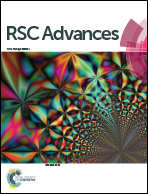China rose-derived tri-heteroatom co-doped porous carbon as an efficient electrocatalysts for oxygen reduction reaction†
Abstract
Developing Pt replacement catalysts for the cathode oxygen reduction reaction (ORR) is crucial for the application of energy conversion technology. Here, the N, O and S tri-heteroatom-doped, hierarchically porous carbon material was obtained by pyrolysis of natural China rose petals as a precursor, followed by chemical activation and post-treatment with melamine. The results demonstrated that the micro/nano-structures of rose petals provide a hard template to form hierarchically porous structures, favorable for the mass transportation and electrolyte, while the saccharides in the rose petals were used as precursors for carbon. Moreover, the amino acids of rose petals and the additive melamine acted as the source of heteroatoms, thus creating enormous active sites for ORR. The as-prepared catalyst therefore displays an excellent electrocatalytic activity similar to the performance of Pt/C in both alkaline and acid media, long term durability and better tolerance for methanol crossover/CO poisoning effects than commercial Pt/C, making it a promising alternative for platinum and other expensive metal-based catalysts toward ORR.


 Please wait while we load your content...
Please wait while we load your content...